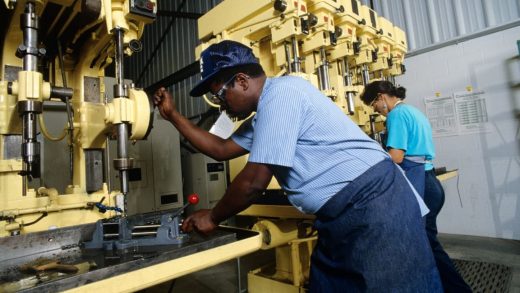Heavy industry needs more diversity. Here’s why
During times of economic turmoil, women and underrepresented groups—those whose gains are more recent in the workplace—experience a disproportionate negative economic impact. Unless we address this proactively, we are at risk of undoing decades’ worth of progress.
Approaching recovery with a strong equity lens is critical, particularly in a time when the impact of COVID-19, high unemployment rates, economic inequalities, and systemic racism are being acutely felt in Black communities. If we let inclusion and diversity take a backseat, America’s existing social and economic gaps will become even wider.
For nearly two years before the COVID-19 pandemic hit, the U.S. had more jobs open than unemployed workers. Additionally, more women were participating in the labor force than men, for the second time in U.S. history. Female representation was increasing at faster rates than before in male-dominated industries from transportation and logistics to construction and manufacturing—where jobs were plentiful and skilled labor hard to find.
The unemployment rate for Black Americans was also decreasing, falling to a record low in August 2019 (5.5%), yet it remained 1.8 percentage points higher than the national average of 3.7%.
As the number of women increased in heavy industry—including operations-intensive industries ranging from manufacturing to aviation—representation at the executive level also inched forward. However, our latest research published in May shows that at 18%, heavy industry still has the lowest levels of gender diversity at senior levels, lower than all other industries surveyed. It’s also six percentage points behind the industry leaders in healthcare and financial services. Across all industries, 30% of companies are fast movers in ethnic representation, which is 12 percentage points higher than in heavy industry.
Companies continue to grapple with the implications of COVID-19. Some are faced with devastating losses of revenue, interrupted operations and supply chains, and challenges to liquidity and solvency, while others are coping with enormous and unexpected spikes in demand.
Companies are also facing scrutiny on how, or if, they responded to the death of George Floyd and the public outcry for action against racial injustice across the U.S. As companies work through these challenges and struggle to respond and survive in this environment, inclusion and diversity in the workplace could quickly become an afterthought, instead of a strategic priority.
Organizations can start with systemic change to tackle systemic inequalities internally. They can foster a culture where inclusion is hardwired throughout an organization, from hiring practices to retention to promotions.
The upside of gender and ethnic diversity has been proven time and time again. Across more than 1,000 companies and 15 countries, McKinsey’s data bear this out. Companies in the top quartile of gender and ethnic diversity were 25% and 36% more likely to financially outperform those in the bottom quartile, respectively.
What do many of the top-quartile companies in diversity have in common? They take an integrated approach to hiring, retaining, and promoting diverse talent within their organization that is championed by the CEO and driven by the leadership team. Diversity leaders are also more likely to take a broader view of accountability, with leaders scrutinized not just for whether they hit their financial targets, but how—and to what degree they incorporate diversity and inclusion along the way. In short, they’re judged not only on performance but also on health measures.
There is also a penalty for companies that are not diverse. Companies that were in the bottom quartile of diversity were 19% less likely to show above-average profitability. Unfortunately, at the rate of current improvement, it will take 24 years to reach executive-team parity in the U.S., and 29 years to reach parity in the U.K.
We mapped companies according to their executive teams’ 2014 diversity level, focusing especially on whether it was 20% or higher for women and whether minorities’ representation equaled at least 20% of their share of the local population. We then reviewed the companies’ percentage-point improvement over the subsequent five years, highlighting those whose female representation rose more than 10 percentage points or whose minority representation rose more than 25.
The bad news is that half of all companies have made either negative or not much progress at all. But a small group of leaders that started with higher diversity numbers improved by more than 10 percentage points. So what are the 5% of companies that are leaders in gender diversity and the 15% of companies that are leaders in ethnic diversity doing? They are taking bold actions both on diversity and on inclusion, adopting systematic, business-led approaches to diversity, inclusion, and equity.
Change starts from the top and requires deep accountability across businesses and functions. Attracting, developing, and promoting diverse talent while fostering an inclusive culture requires action at every level of an organization. For example, one multinational utility provides “Global Effectiveness” training, which fosters insights about global differences and strengthens manager and employee capabilities in working across countries, cultures, and languages.
“Diversity and inclusion is not just about setting targets and having women on the slate,” says the utility’s chief
human resources officer and executive vice president. “We are spending significant time on education—building the business case for D&I and sharing why it’s business-critical.”
Companies across industries had to react extremely quickly to COVID-19. Now, they have an opportunity to leapfrog and accelerate positive change, in terms both of what the future of work could look like and how it is inclusive and open to diverse talent across levels of the organization. “Given how much rapid change we have been through in the last few months,” says one financial services leader, “we can’t squander this opportunity to reimagine what the future could look like.”
Kweilin Ellingrud and Kevin Dolan are senior partners at McKinsey & Company.
(20)



